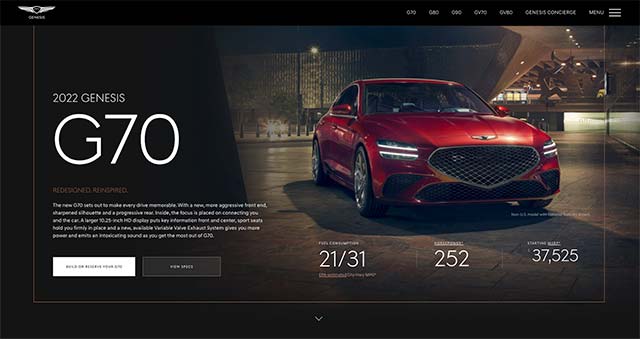UX / Research / Design
GENESIS.com
Redesign
MAIN Objective

Genesis, the luxury brand of Hyundai Motor America was launched in 2017 to compete in the luxury automotive market. The brand launched with a site that was geared towards marketing and less on lead generation. As leads and site visits declined over time, the site needed a redesign to focus on lead generation and brand awareness.
Strategy kickoff
UX workshops and stakeholder interviews were held. In a six hour workshop we laid out some of the user goals, business requirements, mission statement and pain points of the current execution of the website. Priorities were determined based on level of effort and impact to users.


UX Research
I needed to understand who our users were and the various tasks and use cases that they performed. I also needed to deep dive in understanding why the site was underperforming with our users.
Usertesting.com
Working with the UX researcher, a series of benchmarking user tests were created to see any gaps or pain points within the Genesis.com experience.
Users were given specific tasks such as:
- Starting from the home page, what are available safety features of the 2019 [MAKE][MODEL]? [Success: Yes, No]
- Starting from the home page, what is the final cost of a [MAKE][MODEL] with a V6 engine, black wheels, red interior? [Success: Yes, No]
What we found out from these series of tests was that users had difficulty finding pricing and specs info which made it difficult to complete these tasks on the Genesis.com website but easy to complete on competitor sites.
Competitive Analysis
A competitive analysis was conducted on various luxury OEM competitor sites. Gaps on the Genesis.com site were uncovered during the analysis such as lack of payment calculation, comparative specifications and trade in functionality.
Personas
Moderated and un-moderated user interviews were conducted and patterns started to form among the results. Personas were formed based on their needs, user goals, pain points and sentiment.
With this segmentation, these personas were the “north star” for the design team which helped with empathizing with our users.
DESIGN
Design System
Working with the team and 3rd party vendor, a design system was created to provide a single source-of-truth for all design.
This reduced much confusion amongst the team as no longer were we using Photoshop files with different variations for UI elements.


Sketch – Wireframing
Wireframes were created utilizing Sketch, a vector-based UI tool. Components were built out leveraging Sketch symbols and Sketch libraries for quick implementation and iteration.
A design system was created in order to leverage these Sketch components. This process reduced about 50% of the time that it used to take creating wires and comps within Photoshop.
Abstract – Design Repository
Abstract was leveraged to store all UX related Sketch files. Multiple UX designers can work on a single Sketch file without worrying about overriding each other’s work.
A “github-like” system of branching with a check in/out system allowed for a seamless design experience.
Design system related libraries can also be linked to projects for a single source of truth for all library files. Anytime these design libraries were updated, designers are notified of these changes.


Invision – Prototyping & Spec Handoff
Client and internal reviews were conducted via Invision. Client feedback was instrumental in creating a feedback loop for iteration on UX design.
Jira tickets are assigned to UX tasks and can be linked to Invision for dev handoffs. The Jira tickets provide further insight for devs and Confluence docs were created for FRDs (Functional Requirement Documents) to provide to devs for details specifications and interaction guidelines.

METRICS
After launching the Genesis.com redesign we saw a 25% uplift in leads in the first few months. Sales increased in 2019 over 114% compared to 2018.
Page Views
Leads Submitted
% Increase in Sales (2019 vs 2018)
conclusion
Genesis.com redesign was a success and was well received with users and stakeholders alike. Live A/B tests are run (via Adobe Target) to for site optimization. Some legacy pages still exist as an artifact of the previous incarnation of the website and are being updated to make the user journey consistent from end to end. Next steps are to implement personalization through a CDP (Customer Data Platform) via look-alike models and user profile data.
Other Case Studies






